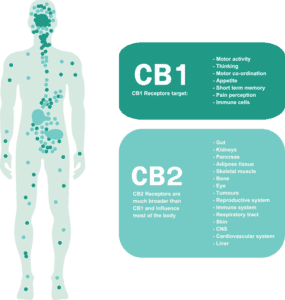
What is the endocannabinoid system?
This is a fundamental question in the understanding of CBD and hemp extracts. At Danodan, we want to help you to better understand the history, science, and potential of our full-spectrum water-soluble CBD products.
One of the central parts of this discussion will always be the endocannabinoid system. This is where our body interacts with many of the compounds found in therapeutic hemp and cannabis products. So today we ask, what is the endocannabinoid system?
Our Endocannabinoid System
First thing first: not a lot is known about the endocannabinoid system (ECS), as it was only “discovered” back in the early 1990s. This may surprise you, since the ECS is present in nearly all animals, and is thought to have evolved over the last 500 million years!
Scientists are continually learning more about the important role the ECS plays within our body. In essence, the ECS is responsible for responding to environmental stimuli and communicating with other systems in our body. These responses play vital roles in regulating functions like: pain, memory, mood, appetite, stress, sleep, metabolism, immune function, inflammation, motor control, liver function, and reproductive function.(1,2) The ECS communicates with every other system in the body, helping it stay in balance, or what is called homeostasis.(3)
The functions of the ECS have both short-term and long-term implications. They affect regular bodily functions, our response to acute trauma and injury, and managing and combating chronic diseases and conditions. This is why a healthy ECS is so important for longevity and well-being.
I know it’s confusing to envision the role that the ECS plays in our body. So, to begin, let’s consider an analogy to better help us understand how the ECS works and what it does.
911 – A Vital Public Service
In North American, we know that 911 is the number to call in an emergency. (In other parts of the world, the same services are accessible by calling 112 – an important fact if you travel a lot).
911 dispatchers answer emergency calls, take information, and disseminate it to the appropriate response agencies. These agencies can include: Fire, Ambulance, Police, Crisis Intervention, Non-Emergency Services, and others.
911 dispatchers decide who to call, how to prioritize competing emergencies, what information they need, and where available services are located. They do all this while interacting with someone on the other end of the line who is potentially experiencing a traumatic event. These dispatchers need extensive training and certification, and benefit from skills such as clear and effective communication, multitasking, problem solving, and empathy.
Of course, 911 response is itself dependent on a variety of factors, and need to be properly supported in order to function well. They need adequate staffing, working telephones, computers, GPS, electricity, and lots of other inputs and information in order to be as effective as possible. At the end of the day, all of these factors are reliant on adequate funding to maintain an acceptable level of service.
Conversely, when 911 services are disrupted, public safety is negatively affected. First responders are delayed, information is inaccurate, and the risk of damage, injury, or loss of life increases.
We all want our 911 services to be effective and reliable, because we know that they are in our communities and may be needed at any time. Well, as you likely have already figured out, our ECS is just as important within our own body.
Our Endocannabinoid System: the 911 of Our Body
Our ECS serves a function very similar to 911 services. The ECS is designed to respond to environmental stimuli and send signals to the appropriate bodily systems. Just as a 911 dispatcher may respond to a specific incident at a single location or a natural disaster over a broad area, our ECS can respond to pain in a certain joint, or it can communicate with immune cells all over the body.
Once these signals are received, the specific bodily system acts accordingly. Just like how a 911 dispatcher tells the local fire station about a structure fire, it is then that station’s responsibility to go fight the fire.
The role of 911 dispatchers is to respond to emergencies and work to restore peace; our ECS works in the same way to help our body respond to maintain homeostasis, or relative equilibrium.
So what are the specific components of the ECS, and how do they respond to our body’s communications?
Endocannabinoids, Receptors, and Enzymes
There are three main components in the ECS: endocannabinoids, receptors, and enzymes. Endocannabinoids are the main signaling component of the ECS, and are produced by our own bodies (“endo” = within, so they are cannabinoids made within our body). There are two main types of endocannabinoids: anandamide (AEA) and 2-arachidonoylglyerol (2-AG).
Endocannabinoids are produced by cells and organs throughout our bodies. Their levels at any moment are influenced by a variety of factors, including sleep, exercise, inflammation, pain, and stress. Each of these circumstances has varying effects on our endocannabinoid levels, some bad, some good.(4)
When our ECS identifies something which requires the attention of another system, it releases specific endocannabinoids to convey this message. These endocannabinoids then circulate through our body and relay signals to specific ECS receptors.
There are two main types of receptors: CB1 and CB2. CB1 receptors are found mostly in the areas of the brain and spinal cord but also on certain cells in the immune system, liver, reproductive system, kidney, and lungs.
CB2 receptors are found on cells throughout the body, on organs like the heart and liver, and especially on immune system cells.(2) The predominance of CB2 receptors on immune cells is why many believe the ECS plays a pivotal role in regulating inflammation, which is seen as a key contributor in many diseases.(3)
Once the endocannabinoids have transmitted their message to the appropriate receptors, enzymes break down the endocannabinoids so they can be digested and disposed of through our natural processes. Our ECS then produces new endocannabinoids, and the whole process begins again.
Basically, the ECS helps our body respond to any and all internal or external triggers in a responsible, level-headed manner, in order to maintain homeostasis and prevent long-term damage and potential disease.(3)
These potential outcomes vary greatly depending on the system that interacts with the ECS. Here are just a few examples of a bodily system, and the conditions associated with that system which the ECS may help combat:(3)
- Central nervous system (brain, spinal cord): schizophrenia, dementia, Parkinson’s disease, depression, Alzheimer’s disease, and traumatic brain injury.
- Cardiovascular System: diabetes, cardiovascular disease, high blood pressure, heart attack, and stroke.
- Musculoskeletal System: arthritis, osteoporosis, chronic pain, joint inflammation, and even recovery from workouts.
Quite the list, eh?
In fact, even George Kunos at the National Institutes of Health (NIH) believes the ECS could be a game-changer. In his words, “Modulating endocannabinoid system activity may have therapeutic potential in almost all diseases affecting humans.”(3) That’s a big statement from the Senior Investigator and Scientific Director in the National Institute of Alcohol Abuse and Alcoholism at the NIH.
CBD, THC, and Other Phytocannabinoids
As researchers have discovered, endocannabinoids aren’t the only things that interact with our ECS. Plant-based cannabinoids, or phytocannabinoids (phyto = plant) can also interact with our ECS, although in different and often mysterious ways.
Two of the main phytocannabinoids being studied are THC and CBD. In fact, it was research into THC that led to the discovery of the ECS in the first place!
For its part, THC has shown the ability to bind to both CB1 and CB2 receptors, acting like our body’s own endocannabinoids. While this shows how THC has potential as a therapeutic agent, it also has some scientists worried about over-stimulating or exhausting our ECS.
CBD, however, is a much trickier case to crack. At this point in time, most research suggests that CBD doesn’t bind to receptors the same way that THC or endocannabinoids do. Instead, researchers are suggesting that CBD actually helps our own endocannabinoids remain in our system longer before they are broken down by enzymes, keeping our ECS more active.
Research also suggests that CBD actually reduces the psychoactive effect of THC, the effect that makes you “high.” But the finer details of CBD’s mechanism of action are still being investigated.(2)
But don’t worry: even though we don’t fully understand how CBD interacts with our ECS, there is still optimism amongst the medical community. Although scientists generally agree that more and better research is needed to draw clearer conclusions, preliminary studies into the therapeutic potential of hemp-derived phytocannabinoids is very exciting.(2) Researchers are increasingly confident and excited about the support that CBD can provide our ECS, helping keep our body ready to respond to life’s emergencies.
Danodan to Support Your ECS
Because of our whole plant process, Danodan products contain more than just CBD; they contain many other phytocannabinoids, as well as terpenes, flavonoids, chlorophyll, and other beneficial compounds. This is what we call the Whole Plant Effect.
This full-spectrum combination of plant components is believed to create a more balanced, effective, and natural response in our ECS. It’s the same principle as eating a food high in vitamin C is considered healthier than taking a dose of isolated vitamin C.
We’ll be learning more about the Whole Plant Effect very soon. For now, thanks for learning about the endocannabinoid system, and please leave your questions, comments, or article ideas below – we’d love to hear them!
We here at Danodan are committed to the education of our staff, our customers, and our community. We believe that our products are superior to many of the CBD products on the market today, and that it will support many of our body’s natural processes in a more natural, holistic way. We invite you to experience the Whole Plant Effect, and share your stories in the comments below or share them with me, andrew@danodan.com.
References:
- Human Endocannabinoid System. UCLA Health. https://www.uclahealth.org/cannabis/human-endocannabinoid-system. Accessed 11 Dec 2019.
- Raypole C. A Simple Guide to the Endocannabinoid System. Healthline. https://www.healthline.com/health/endocannabinoid-system. Reviewed 17 May 2019. Accessed 11 Dec 2019.
- Corroon J, Felice J. The Endocannabinoid System and its Modulation by Cannabidiol (CBD). Altern Ther Health Med. 2019;25(S2):6-14.
- Hillard, C. Circulating Endocannabinoids: From Whence Do They Come and Where are They Going?. Neuropsychopharmacol. 43, 155–172 (2018) doi:10.1038/npp.2017.130
This statement has not been evaluated by the FDA. This product is not intended to diagnose, treat, cure, or prevent any disease. Please consult your doctor or medical professional before beginning any new supplements or medications.

